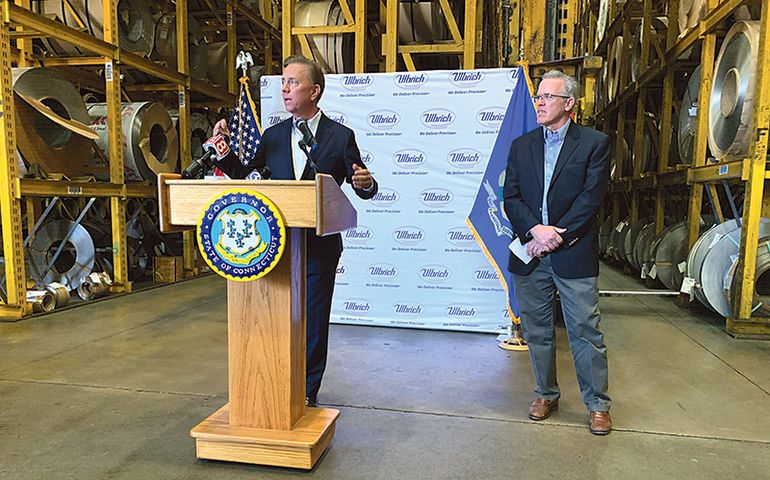Processing Your Payment
Please do not leave this page until complete. This can take a few moments.
-
News
-
Editions
-
- Lists
-
Viewpoints
-
HBJ Events
-
Event Info
- 2024 Economic Outlook Webinar Presented by: NBT Bank
- Best Places to Work in Connecticut 2024
- Top 25 Women In Business Awards 2024
- Connecticut's Family Business Awards 2024
- What's Your Story? A Small Business Giveaway 2024 Presented By: Torrington Savings Bank
- 40 Under Forty Awards 2024
- C-Suite and Lifetime Achievement Awards 2024
- Connecticut's Health Care Heroes Awards 2024
-
-
Business Calendar
-
Custom Content
- News
-
Editions
View Digital Editions
Biweekly Issues
- April 15, 2024
- April 1, 2024
- March 18, 2024
- March 4, 2024
- February 19, 2024
- February 5, 2024
- January 22, 2024
- January 8, 2024
- Dec. 11, 2023
- + More
Special Editions
- Lists
- Viewpoints
-
HBJ Events
Event Info
- View all Events
- 2024 Economic Outlook Webinar Presented by: NBT Bank
- Best Places to Work in Connecticut 2024
- Top 25 Women In Business Awards 2024
- Connecticut's Family Business Awards 2024
- What's Your Story? A Small Business Giveaway 2024 Presented By: Torrington Savings Bank
- 40 Under Forty Awards 2024
- C-Suite and Lifetime Achievement Awards 2024
- Connecticut's Health Care Heroes Awards 2024
Award Honorees
- Business Calendar
- Custom Content
CT’s new manufacturing czar Cooper lays out priorities, challenges
 Photo | Contributed
Gov. Ned Lamont introduces new Chief Manufacturing Officer Colin Cooper.
Photo | Contributed
Gov. Ned Lamont introduces new Chief Manufacturing Officer Colin Cooper.
More Information
Connecticut’s first-ever Chief Manufacturing Officer Colin Cooper is a bit of an anomaly: a business-backed bureaucrat.
Gov. Ned Lamont first announced his intention to create the position in June, saying the manufacturing “czar” would promote one of Connecticut’s most important industries, which employs 161,000 people and generates $14.9 billion in wages and $123 million in corporate income taxes annually. The new position will also coordinate between state actors and private businesses, namely to head off a workforce shortage that is expected to worsen.
But, while the state and industry fret with how to fill the manufacturing-workforce pipeline, both appear to look at Cooper with optimism.
“Colin is certainly the right person for this job,” said Jameson Scott, executive director of the New Haven Manufacturers Association, and an early supporter of installing Cooper in the newly established position. “I know I can go to Colin [with issues or concerns].”
Cooper is a known commodity to Connecticut manufacturers. He ran Eastford-based aeroparts maker Whitcraft Group as chief executive for 20 years, growing it from a one-plant operation generating $20 million annually to four facilities in Connecticut and operations in five other states making over $250 million.
When Department of Economic and Community Development (DECD) Commissioner David Lehman was searching for someone to fill the new chief manufacturing position, Cooper was on a shot list of candidates approved by the Connecticut Manufacturers’ Collaborative, a group of nine state-based manufacturing and business associations. Additionally, Cooper said state actors seem to be onboard with the effort to strengthen manufacturing here.
“I’ve had interactions with people in the different departments in the state, and I think there is buy-in, in terms of what the goals and objectives are,” Cooper said.
For Cooper, those objectives include creating a sustainable workforce pipeline, promoting Connecticut as a good landing spot for in- and out-of-state manufacturers and educating the public and state government about what the industry entails and needs to succeed.
Atop his to-do list is revamping the industry’s workforce pipeline, which faces stress from a pending retirement wave. About 27 percent of the current manufacturing workforce is expected to retire by 2024, creating thousands of open positions, according to a recent industry survey by the Connecticut Business & Industry Association.
In addition, of the 350 Connecticut manufacturers that responded to that survey, 60 percent said workforce was their most significant immediate need, while 89 percent of those respondents said recruiting qualified workers is their primary challenge.
Part of the problem stems from a misunderstanding of what manufacturing jobs actually entail, Cooper said.
“There’s still a perception that manufacturing is dirty and loud and messy, and that’s just not the case,” Cooper said. “If you go into most of our manufacturing facilities now in the state, they’re clean, they’re well organized … and they’re just chock full of high-tech equipment.”
That’s why messaging will play an important role, as the industry and state try to encourage more students to consider a manufacturing career. While leading Whitcraft, Cooper said he provided training to many employees who came in with no post-secondary education, so he can speak from experience about developing talent.
Some of what the state needs to do in regards to job training is already being done, Cooper said, just on a smaller scale than what’s needed. For example, apprenticeship programs have been successful; cities and towns are increasing technical high school resources; and eight of Connecticut’s 12 community colleges now offer manufacturing programs.
“We need to continue that outreach and education so that we continue to have a flow of qualified candidates into those programs,” Cooper said. “Making sure that we have the resources behind [workforce-development programs] and that they’re coordinated so they compliment each other, is one of my main objectives.”
Selling CT
Another hurdle the industry grapples with is struggling to sell Connecticut to out-of-state companies, Scott said. While he’s seen a recent uptick in international interest in the state as a locus for manufacturing business, Scott said criticism painting Connecticut as anti-business has largely gone unanswered by the state and manufacturing sector.
“It’s just as much our fault,” Scott said. “We have not done a good enough job [promoting Connecticut].”
Cooper said highlighting the state’s assets will be a priority in his out-of-state recruitment efforts. The sales pitch will include: Connecticut’s proximity to major markets, including Boston and New York; ready access to capital; and a state government making efforts to bolster the industry.
“We need to get the word out about the strengths of Connecticut,” he said.
With his position helping establish a line of communication between state government and manufacturers, Cooper said he thinks public/private partnerships will play a large role in revamping the industry. That’s in keeping with the Lamont administration, which has touted partnerships between private industry and government.
And the way Cooper is approaching the position, he’ll be a nexus between government and a host of industry stakeholders, taking stock of what efforts are working, which ones are not and what programs should be expanded.
“I think having somebody in this position can work as a clearinghouse for all those different initiatives,” Cooper said. “It’s just a matter of knowing what’s going on, having a full inventory of the different initiatives going on, and then putting our resources behind the ones that are most effective.”
By The Numbers: Connecticut’s manufacturing industry
4,011
The number of manufacturing companies in Connecticut.
160,900
The number of manufacturing employees in the state.
$96,279
The average manufacturing wage in Connecticut.
$1.48B
The amount manufacturers spend annually in capital expenditures. $30.8B The amount manufacturing contributed to Connecticut’s Gross State Product in 2018.
I am convinced that this new position strengthens the LEADERSHIP needed to communicate more effectively the tremendous talent we have here...not just workers but also business owners who are well beyond maintaining the status quo.
Here's to the success of Mr. Cooper.

2022 Giving Guide
This special edition informs and connects businesses with nonprofit organizations that are aligned with what they care about. Each nonprofit profile provides a crisp snapshot of the organization’s mission, goals, area of service, giving and volunteer opportunities and board leadership.
Learn more
Subscribe
Hartford Business Journal provides the top coverage of news, trends, data, politics and personalities of the area’s business community. Get the news and information you need from the award-winning writers at HBJ. Don’t miss out - subscribe today.
Subscribe
2024 Book of Lists
Delivering Vital Marketplace Content and Context to Senior Decision Makers Throughout Greater Hartford and the State ... All Year Long!
Read Here-
2022 Giving Guide
This special edition informs and connects businesses with nonprofit organizations that are aligned with what they care about. Each nonprofit profile provides a crisp snapshot of the organization’s mission, goals, area of service, giving and volunteer opportunities and board leadership.
-
Subscribe
Hartford Business Journal provides the top coverage of news, trends, data, politics and personalities of the area’s business community. Get the news and information you need from the award-winning writers at HBJ. Don’t miss out - subscribe today.
-
2024 Book of Lists
Delivering Vital Marketplace Content and Context to Senior Decision Makers Throughout Greater Hartford and the State ... All Year Long!
ABOUT
ADVERTISE
NEW ENGLAND BUSINESS MEDIA SITES
No articles left
Get access now
In order to use this feature, we need some information from you. You can also login or register for a free account.
By clicking submit you are agreeing to our cookie usage and Privacy Policy
Already have an account? Login
Already have an account? Login
Want to create an account? Register
Get access now
In order to use this feature, we need some information from you. You can also login or register for a free account.
By clicking submit you are agreeing to our cookie usage and Privacy Policy
Already have an account? Login
Already have an account? Login
Want to create an account? Register






1 Comments